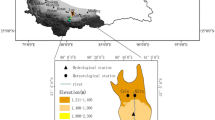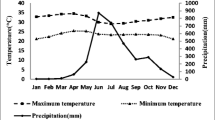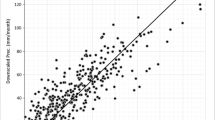Abstract
This paper tried to reconstruct the time series (TS) of monthly average temperature (MAT), monthly accumulated precipitation (MAP), and monthly accumulated runoff (MAR) during 1901–1960 in the Kaidu River Basin using the Delta method and the three-layered feed forward neural network with backpropagation algorithm (TLBP-FFNN) model. Uncertainties in the reconstruction of hydrometeorological parameters were also discussed. Available monthly observed hydrometeorological data covering the period 1961–2000 from the Kaidu River Basin, the monthly observed meteorological data from three stations in Central Asia, monthly grid climatic data from the Climatic Research Unit (CRU), and Coupled Model Intercomparison Project Phase 3 (CMIP3) dataset covering the period 1901–2000 were used for the reconstruction. It was found that the Delta method performed very well for calibrated and verified MAT in the Kaidu River Basin based on the monthly observed meteorological data from Central Asia, the monthly grid climatic data from CRU, and the CMIP3 dataset from 1961 to 2000. Although calibration and verification of MAP did not perform as well as MAT, MAP at Bayinbuluke station, an alpine meteorological station, showed a satisfactory result based on the data from CRU and CMIP3, indicating that the Delta method can be applied to reconstruct MAT in the Kaidu River Basin on the basis of the selected three data sources and MAP in the mountain area based on CRU and CMIP3. MAR at Dashankou station, a hydrological gauge station on the verge of the Tianshan Mountains, from 1961 to 2000 was well calibrated and verified using the TLBP-FFNN model with structure (8,1,1) by taking MAT and MAP of four meteorological stations from observation; CRU and CMIP3 data, respectively, as inputs; and the model was expanded to reconstruct TS during 1901–1960. While the characteristics of annual periodicity were depicted well by the TS of MAT, MAP, and MAR reconstructed over the target stations during the period 1901–1960, different high frequency signals were captured also. The annual average temperature (AAT) show a significant increasing trend during the 20th century, but annual accumulated precipitation (AAP) and annual accumulated runoff (AAR) do not. Although some uncertainties exist in the hydrometeorological reconstruction, this work should provide a viable reference for studying long-term change of climate and water resources as well as risk assessment of flood and drought in the Kaidu River Basin, a region of fast economic development.











Similar content being viewed by others
References
Akaike H (1974) A new look at the statistical model identification. IEEE Trans Autom Control 19:716–723
ASCE Task Committee on Application of Artificial Neural Networks in Hydrology (2000) Artificial neural networks in hydrology I: hydrology application. J Hydrol Eng 5(2):124–137
Bradley RS, Jones PD (1992) Climate since AD1500. Routledge, London, pp 511–537
Busuioc A, Chen D, Hellstrom C (2001) Performance of statistical downscaling models in GCM validation and regional climate change estimates: application for Swedish precipitation. Int J Climatol 21:557–578
Cannas B, Fanni A, See L, Sias G (2006) Data preprocessing for river flow forecasting using neural networks: wavelet transforms and data partitioning. Phys Chem Earth 31:1164–1171
Chapman L, Thornes JE (2003) The use of geographical information systems in climatology and meteorology. Prog Phys Geogr 27:313–330
Chen YN, Xu CC, Hao XM, Li WH, Chen YP, Zhu CG, Ye ZX (2009) Fifty-year climate change and its effect on annual runoff in the Tarim River Basin, China. Quat Int 208:53–61, in Chinese
Conway D, Wilby RL, Jone PD (1996) Precipitation and air flow indices over the British Isles. Clim Res 7(2):169–183
Dou Y, Chen X, Bao AM, Li LH (2011) The simulation of snowmelt runoff in the ungauged Kaidu River Basin of TianShan Mountains, China. Environ Earth Sci 62(5):1039–1045
Dubrovsky M, Buchtele J, Zalud Z (2004) High-frequency and low-frequency variability in stochastic daily weather generator and its effect on agricultural and hydrologic modeling. Clim Chang 63:145–179
Esper J, Cook ER, Schweingruber FH (2002) Low-frequency signals in long tree-ring chronologies for reconstructing past temperature variability. Science 295:2250–2253
Fang KY, Gou XH, Chen FH (2011) Large-scale precipitation variability over Northwestern China inferred from tree rings. J Clim 24(13):3457–3468
Fowler HJ, Kilsby CG, O’Connell PE (2000) A stochastic rainfall model for the assessment of regional water resource systems under changed climatic conditions. Hydrol Earth Syst Sci 4:261–280
Gupta HV, Sorooshian S, Yapo PO (1999) Status of automatic calibration for hydrologic models: comparison with multilevel expert calibration. J Hydrol Eng 4(2):135–143
Hao ZH, Li L, Xu Y, Ju Q (2009) Study on Delta-DCSI downscaling method of GCM output. J SiChuan Univ (Eng Sci Ed) 41(5):1–7, in Chinese
Hay LE, Wilby IL, Leavesley GH (2000) A comparison of delta change and downscaled GCM scenarios for three mountainous basins in the United States. J Am Water Resour Assoc 36(2):387–397
Huth R (1999) Statistical downscaling in central Europe: evaluation of methods and potential predictors. Clim Res 13:91–101
Jeffrey SJ, Carter JO, Moodie KB, Beswick AR (2001) Using spatial interpolation to construct a comprehensive archive of Australian climate data. Environ Model Softw 16:309–330
Karl TR, Wang WC, Schlesinger ME, Knight RW, Portman D (1990) A method of relating general circulation model simulated climate to observed local climate. Part I: seasonal statistics. J Clim 3:1053–1079
Le Treut H, Somerville R, Cubasch U, Ding YH, Mauritzen C, Mokssit A, Peterson T, Prather M (2007) Historical overview of climate change. In: Solomon S, Qin D, Manning M, Chen Z, Marquis M, Averyt KB, Tignor M, Miller HL (eds) Climate change 2007: the physical science basis. Contribution of working group I to the Fourth Assessment Report of the Intergovernmental Panel on Climate Change. Cambridge University Press, Cambridge
Levenberg K (1944) A method for the solution of certain non-linear problems in least squares. Q Appl Math 2:164–168
Li XM, Jiang FQ, Li LH, Wang GG (2011a) Spatial and temporal variability of precipitation concentration index, concentration degree and concentration period in Xinjiang province, China. Int J Climatol 31:1679–1693
Li XM, Li LH, Guo LP, Zhang FY, Suwannee A, Shang M (2011b) Impact of climate factors on runoff in the Kaidu River watershed: path analysis of 50-year data. J Arid Land 3(2):132–140
Marquardt D (1963) An algorithm for least-squares estimation of nonlinear parameters. SIAM J Appl Math 11(2):431–441
Marquinez J, Lastra J, Garcia P (2003) Estimation models for precipitation in mountainous regions: the use of GIS and multivariate analysis. J Hydrol 270:1–11
Mason SJ (2004) Simulating climate over Western North America using stochastic weather generators. Clim Chang 62:155–187
May RJ, Maier HR, Dandy GC (2009) Data splitting for artificial neural networks using SOM-based stratified sampling. Neural Netw 23:283–294
Moriasi DN, Arnold JG, Van Liew MW, Bingner RL, Harmel RD, Veith TL (2007) Model evaluation guidelines for systematic quantification of accuracy in watershed simulations. Am Soc Agric Biol Eng 50(3):885–900
Nash JE, Sutcliffe JV (1970) River flow forecasting through conceptual models. Part 1: a discussion of principles. J Hydrol 10(3):282–290
Ninyerola M, Pons X, Roure MJ (2000) A methodological approach of climatologically modeling of air temperature and precipitation through GIS techniques. Int J Climatol 20:1823–1841
Nourani V, Komasi M, Mano A (2009) A multivariate ANN-wavelet approach for rainfall–runoff modeling. Water Resour Manage 23:2877–2894
Olsson J, Uvo CB, Jinno K, Kawamura A, Nishiyama K, Koreeda N, Nakashima T, Morita O (2004) Neural networks for rainfall forecasting by atmospheric downscaling. J Hydrol Eng 9(1):1–12
Shen J, Zhang EL, Xia WL (2001) Records from lake sediments of the Qinghai Lake to mirror climatic and environmental changes of the past about 1000 years. Quat Sci 21(6):508–514, in Chinese
Shi YF, Shen YP, Hu RJ (2002) Preliminary study on signal, impact and foreground of climatic shaft from warm-dry to warm-wet in Northwestern China. J Glaciol Geocryol 24:219–226, in Chinese
Skirvin SM, Marsh SE, McClaranw MP, Mekoz DM (2003) Climate spatial variability and data resolution in a semi-arid watershed, south-eastern Arizona. J Arid Environ 54:667–686
Srinivasulu S, Jain A (2006) A comparative analysis of training methods for artificial neural network rainfall–runoff models. Appl Soft Comput 6:295–306
Tao H, Wang GY, Shao C, Song YD, Zou SP (2007) Climate change and its effects on runoff at the headwater of Kaidu River. J Glaciol Geocryol 29(3):413–417, in Chinese
Tao H, Gemmer M, Bai YG, Su BD, Mao WY (2011) Trends of streamflow in the Tarim River Basin during the past 50 years: human impact or climate change? J Hydrol 400:1–9
Tripathi S, Srinivas VV, Nanjundiah RS (2006) Downscaling of precipitation for climate change scenarios: a support vector machine approach. J Hydrol 330:621–640
Vogl TP, Mangis JK, Rigler AK, Zink WT, Alkon DL (1988) Accelerating the convergence of the backpropagation method. Biol Cybern 59:257–263
Wilby RL, Hay LE, Leavesley GH (1999) A comparison of downscaled and raw GCM output: implications for climate change scenarios in the San Juan River basin, Colorado. J Hydrol 225(1–2):67–91
Wu ZT, Zhang HJ, Krause CM, Cobb NS (2010) Climate change and human activities: a case study in Xinjiang, China. Clim Chang 99:457–472
Xu JH, Ji MH, Lu F (2008) Climate change and its effects on runoff of Kaidu River, Xinjiang, China: a multiple time-scale analysis. Chin Geogr Sci 18(4):331–339, in Chinese
Yang B, Braeuning A, Johnson KR, Shi YF (2002) General characteristics of temperature variation in China during the last two millennia. Geophys Res Lett 29:1029–1040
Zhao FF, Xu ZX (2007) Comparative analysis on downscaled climate scenarios for headwater catchment of yellow river using SDS and Delta methods. Acta Meteorol Sin 65(4):653–662, in Chinese
Zorita E, Storch HV (1999) The analog method as a simple statistical downscaling technique: comparison with more complicated methods. J Clim 12:2474–2489
Acknowledgments
We acknowledge the modeling groups for providing their data for analysis, the PCMDI and the WCRP's Coupled Model Intercomparison Project for collecting and archiving the model output and organizing the model data analysis activity. The data has been collected, analyzed, and are provided by the National Climate Center. This work was financially supported by the State Key Development Program for Basic Research of China (973 program, Grant No. 2010CB951002), the Natural Sciences Foundation of China (Grant No. 40871027), and the opened subject of Xinjiang Key Laboratory of Water Cycle and Utilization in Arid Zone (Grant No. XJYS0907-2011-04).
Author information
Authors and Affiliations
Corresponding author
Rights and permissions
About this article
Cite this article
Li, X., Li, L., Wang, X. et al. Reconstruction of hydrometeorological time series and its uncertainties for the Kaidu River Basin using multiple data sources. Theor Appl Climatol 113, 45–62 (2013). https://doi.org/10.1007/s00704-012-0771-2
Received:
Accepted:
Published:
Issue Date:
DOI: https://doi.org/10.1007/s00704-012-0771-2




